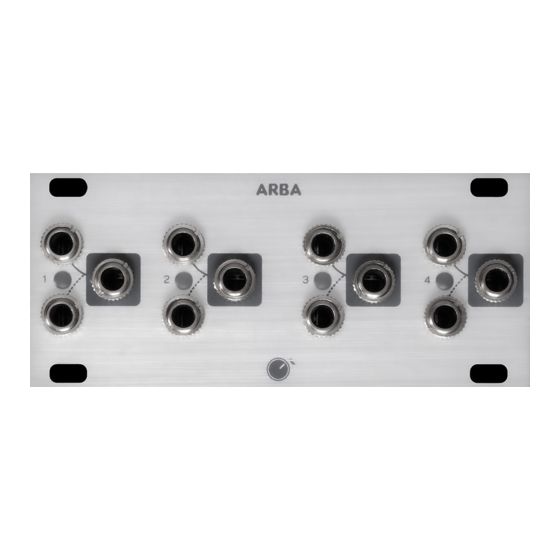
Advertisement
Quick Links
PLUM AUDIO – ARBA
Thanks for purchasing ARBA from Plum Audio!
ARBA provides four Voltage Controlled Amplifiers (VCA) with linear response. It may look like a
simple VCA module but under the hood it is packed with features that unleash a variety of uses.
Three features that distinguish ARBA:
•
Normalization: Everything is normalized to everything – all of the inputs, CV inputs and
outputs are normalized between the four channels so you can use a variety of
configurations depending on how you patch it.
As a result of this feature, you can get a significant gain boost (with CV control!) when you
chain several channels together.
•
Variable sensitivity: Unlike most VCA's in Eurorack that clip easily due to the 5V unity gain
– the cause of this annoying clipping is that many envelope generators output a standard
voltage of 8V – with ARBA you can set the sensitivity of each of the channels (or - how
much voltage needs to reach the CV input to get unity gain at the output) using the four
trimmer resistors located on the back of the module.
•
Limiters: soft clipping diodes will limit the outputs to 10.2 volts peak-to-peak and warm
up the sound (the limiters can be disabled using switches on the back of the module).
The combination of these three features allows a variety of uses, for example:
Quad simple linear VCAs
Stereo VCAs
Summing VCAs
Soft clipper
Distortion with CV control
Level booster (instrument or line level to Eurorack level)
And much more...
Advertisement

Subscribe to Our Youtube Channel
Summary of Contents for Plum Audio ARBA
- Page 1 – the cause of this annoying clipping is that many envelope generators output a standard voltage of 8V – with ARBA you can set the sensitivity of each of the channels (or - how much voltage needs to reach the CV input to get unity gain at the output) using the four trimmer resistors located on the back of the module.
-
Page 2: Inputs And Outputs
The red stripe of the ribbon cable (-12V side) must be oriented to the same side as the “red stripe” marking on the header. Use the four screws supplied to mount ARBA to a free 18HP space in the 1U row of your ●... -
Page 3: Operating Principles
PLUM AUDIO – ARBA OPERATING PRINCIPLES: In this part of the manual you will find a few examples of patches that can be done with ARBA and demonstrations of various aspects of its operating principles, please take your time and try out these patches for a better understanding of the ARBA. - Page 4 To break the normalization, all you need to do is to connect cable into the jack. EXAMPLE 2 - DUAL STEREO VCA: To use ARBA as a stereo VCA you can use the normalization of the CV inputs and share one CV for two (or more) channels.
- Page 5 In this example, only the output of channel 4 is used. This output sums together the outputs signals of channels 1, 2, 3, and 4. In this configuration, you can also use ARBA as a four-channel mixer, and use offset modules like Plum Audio VASAT as CV source to control the gain of each channel manually.
- Page 6 PLUM AUDIO – ARBA EXAMPLE 4 - SHARED INPUT: ARBA can share one input to a few channels. When you leave an input unconnected, the signal is shared from the previous connected input. This is great to sequence different processing for one audio source like several effect units or different filters.
- Page 7 ARBA from hard clipping and distortion. But, if you want to process DC signals that are outside the -/+5.1V range using ARBA, you can only do so with the limiters turned off.
- Page 8 As in the previous example, you can use half of ARBA to control the amount of soft clipping of one signal by using the output of channel 2 and the second half of ARBA is left free for different use.
-
Page 9: Calibration Procedure
PLUM AUDIO – ARBA CHANNEL SENSITIVITY CALIBRATION: On the back of the module, there are four small trimmers that control the overall gain of each channel. Use a small screwdriver if you wish to change the default setting. They are single-turn trimmers. Be gentle so you can feel when the trimmer is reaching its end –...
Need help?
Do you have a question about the ARBA and is the answer not in the manual?
Questions and answers